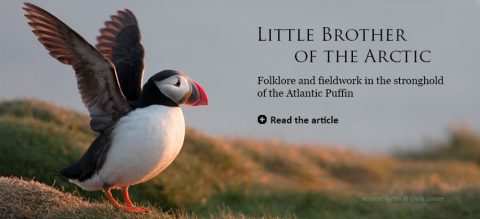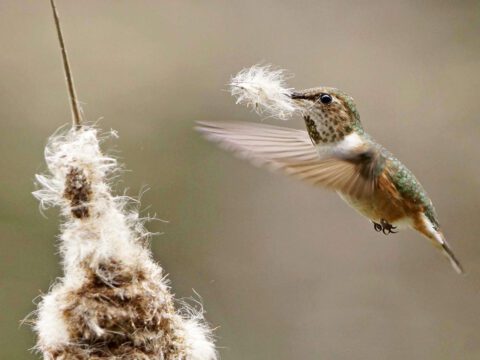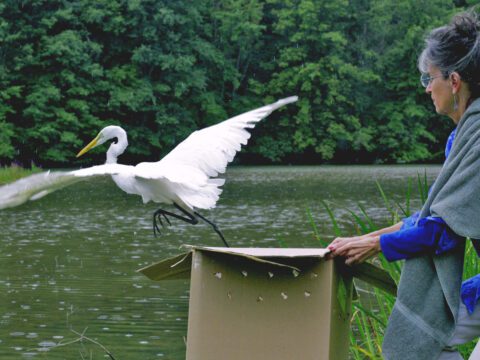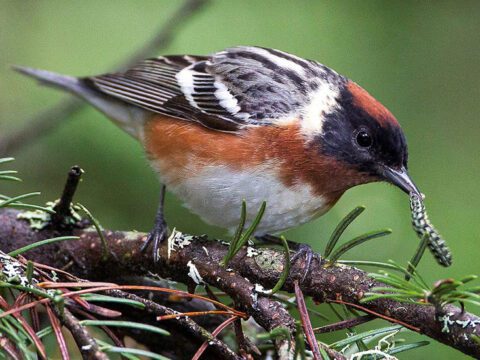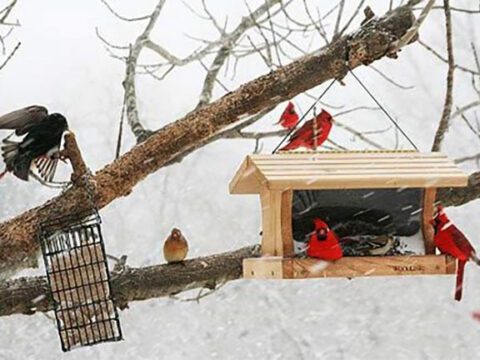Monitoring Migrant Birds in the Night by the Briefest of Chip Notes
By Gustave Axelson
July 15, 2013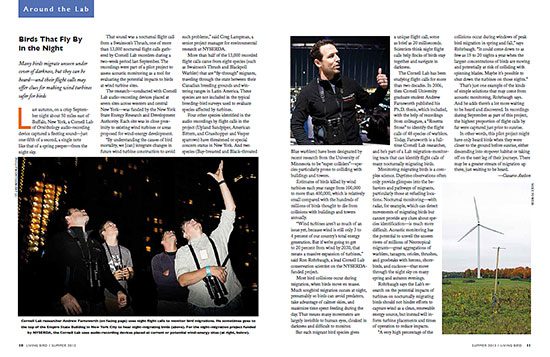
Many birds migrate unseen under cover of darkness, but they can be heard—and their flight calls may offer clues for making wind turbines safer for birds
Last autumn, on a crisp September night about 50 miles east of Buffalo, New York, a Cornell Lab of Ornithology audio-recording device captured a fleeting sound—just one-fifth of a second, a single note like that of a spring peeper—from the night sky.
That sound was a nocturnal flight call from a Swainson’s Thrush, one of more than 13,000 nocturnal flight calls gathered by Cornell Lab recorders during a two-week period last September. The recordings were part of a pilot project to assess acoustic monitoring as a tool for evaluating the potential impacts to birds at wind turbine sites.
The research—conducted with Cornell Lab audio-recording devices placed at seven sites across western and central New York—was funded by the New York State Energy Research and Development Authority. Each site was in close proximity to existing wind turbines or areas proposed for wind-energy development.
“By understanding the causes of bird mortality, we [can] integrate changes in future wind turbine construction to avoid such problems,” said Greg Lampman, a senior project manager for environmental research at NYSERDA.
More than half of the 13,000 recorded flight calls came from eight species (such as Swainson’s Thrush and Blackpoll Warbler) that are “fly-through” migrants, traveling through the state between their Canadian breeding grounds and wintering ranges in Latin America. These species are not included in the typical breeding-bird surveys used to evaluate species affected by turbines.
Four other species identified in the audio recordings by flight calls in the project (Upland Sandpiper, American Bittern, and Grasshopper and Vesper sparrows) have threatened or special concern status in New York. And two species (Bay-breasted and Black-throated Blue warblers) have been designated by recent research from the University of Minnesota to be “super colliders”—species particularly prone to colliding with buildings and towers.
Estimates of birds killed by wind turbines each year range from 100,000 to more than 400,000, which is relatively small compared with the hundreds of millions of birds thought to die from collisions with buildings and towers annually.
“Wind turbines aren’t as much of an issue yet, because wind is still only 3 to 4 percent of our country’s total energy generation. But if we’re going to get to 20 percent from wind by 2030, that means a massive expansion of turbines,” said Ron Rohrbaugh, a lead Cornell Lab conservation scientist on the NYSERDA funded project.
Most bird collisions occur during migration, when birds move en masse. Much songbird migration occurs at night, presumably so birds can avoid predators, take advantage of calmer skies, and maximize time spent feeding during the day. That means many movements are largely invisible to human eyes, cloaked in darkness and difficult to monitor.
But each migrant bird species gives a unique flight call, some as brief as 20 milliseconds. Scientists think night flight calls help flocks of birds stay together and navigate in darkness.
The Cornell Lab has been studying flight calls for more than two decades. In 2006, then Cornell University graduate student Andrew Farnsworth published his Ph.D. thesis, which included, with the help of recordings from colleagues, a “Rosetta Stone” to identify the flight calls of 48 species of warblers. Today, Farnsworth is a fulltime Cornell Lab researcher, and he’s part of a Lab migration-monitoring team that can identify flight calls of many nocturnally migrating birds.
Monitoring migrating birds is a complex science. Daytime observations often only provide glimpses into the behaviors and pathways of migrants, particularly those at refueling locations. Nocturnal monitoring—with radar, for example, which can detect movements of migrating birds but cannot provide any clues about species identification—is much more difficult. Acoustic monitoring has the potential to unveil the unseen rivers of millions of Neotropical migrants—great aggregations of warblers, tanagers, orioles, thrushes, and grosbeaks with herons, shorebirds, and cuckoos—that move through the night sky on many spring and autumn evenings.
Rohrbaugh says the Lab’s research on the potential impacts of turbines on nocturnally migrating birds should not hinder efforts to capture wind as a clean, renewable energy source, but instead will inform turbine placements and times of operation to reduce impacts.
“A very high percentage of the collisions occur during windows of peak bird migration in spring and fall,” says Rohrbaugh. “It could come down to as few as 15 to 20 nights a year when the largest concentrations of birds are moving and potentially at risk of colliding with spinning blades. Maybe it’s possible to shut down the turbines on those nights.”
That’s just one example of the kinds of simple solutions that may come from acoustic monitoring, Rohrbaugh says. And he adds there’s a lot more waiting to be heard and discovered. In recordings during September as part of this project, the highest proportion of flight calls by far were captured just prior to sunrise.
In other words, this pilot project might have only heard birds when they were closer to the ground before sunrise, either descending into stopover habitat or taking off on the next leg of their journeys. There may be a greater stream of migration up there, just waiting to be heard.

All About Birds
is a free resource
Available for everyone,
funded by donors like you
American Kestrel by Blair Dudeck / Macaulay Library
